#check out my classroom wishlist if you want to help add more books to my classroom library
Explore tagged Tumblr posts
Text

In the middle of the school day yesterday I received a text from a friend that I rarely talk to. She works at a high school in a very conservative state and she has recently discovered that a few of her students identify as trans. She was asking for recommendations for books she should buy for her classroom library to help her students feel represented. I quickly ran over to my LGBT Lending Library and grabbed a few titles.

This is no way represents all of the trans-centric stories on my shelf, but I thought it was be a good start.
While taking the picture I remembered that I had an extra copy of When the Moon Was Ours at my house...I also had a pile of books that I had reserved for filling free little libraries around my town. Sooooo! I made her a teacher care package! With a book for her trans students, five other books that will help all students feel represented, rainbow swag, and some teaching tolerance materials.
I wish there was a way all teachers could receive FREE books and resources for students who feel underrepresented. I am just happy I could help one.
@teachingtolerance-blog
@macmillanusa
@glsen
#check out my classroom wishlist if you want to help add more books to my classroom library#representation#trans representation#representation matters#lgbt lending library#classroom library#trans books#lgbt+ books#educhums#teachers helpng teachers#teacher gift#care package#teaching tolerance
75 notes
·
View notes
Text
Before I Come to Your Classroom, Let Me Show You Mine
Hi.
I’m going to spend the rest of the year traveling to classrooms all over the country and talking about the things we are doing super well, and some of the things we could be doing a whole lot better.
I’m sitting in my classroom writing this, late on a Friday afternoon, enjoying the short quiet after a long, loud week. I’m looking around my room, dimly lit and breathing slowly, like the set of a play between performances. If you’re a teacher, I bet I’d like to come visit you soon. Before I do, I thought I’d show you around my room and what I do with my students the first week of school.

I really love my room, and it seems like students do, too. I don’t have a class first hour, but there are always five to 10 kids in here before school hanging out. My desks are old and…desky. I don’t have a lot of room or money for flex seating, and I don’t have the eye or time for Pinterest-worthy bulletin boards. Still, my walls, like my room, are a whole lot better when given to the kids.
It Took a Year to Create a Classroom Library with Books Kids Want to Keep

I am absurdly proud of my classroom library. When I moved into my new classroom last fall, the library was suffering badly from being out-of-date and almost entirely full of White writers. In one year, I have done a whole bunch of stuff to bring the collection to where it is now. I’m not done, not by a long-shot, but my collection now includes many books by people of color and indigenous writers.
I’ve always believed in the power of diverse reading choices, but this year I’ve been especially aware of how important it is to my students. I have a ton of graphic novels and superhero comics, and have started to add books in some of the languages spoken by my students that are not English. My students from Tibet and Haiti have been so happy to see books by and about their people.
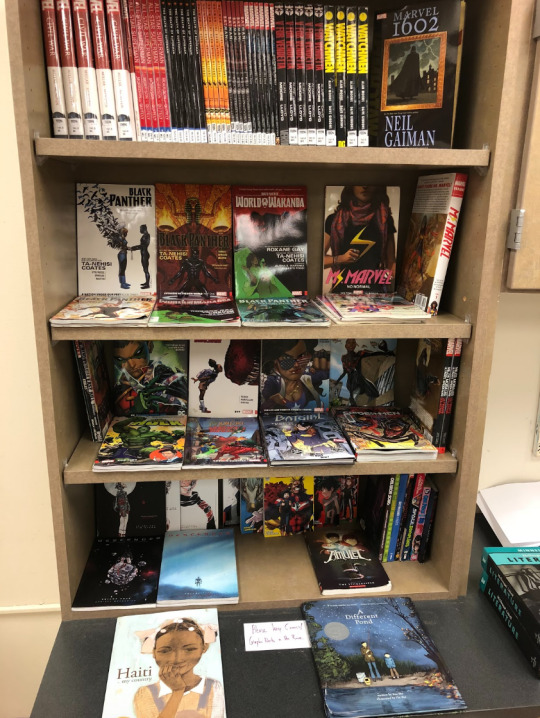
I had a student walk down from the high school this week, looking to borrow a copy of “The Hate U Give.” I started the year with 15 on my shelf and was already down to my last two. I don’t know her name, but she left with a book. I’m not all that worried about getting it back.
By far, the books are the most expensive part of my room, made more so by my not having any sort of book check-out system and encouraging students to take books that seem interesting to them. I’ve written some grants in the last year that have helped out, have sought donations through a constantly updated Amazon wishlist, and have made some money through writing that I’ve often used to buy every book I can that my students may enjoy.
Also, these pictures are from before school started. The library is now a well-used mess and it is perfect.
Now, let me show you how our first week together went down.
Day One: Four Agreements
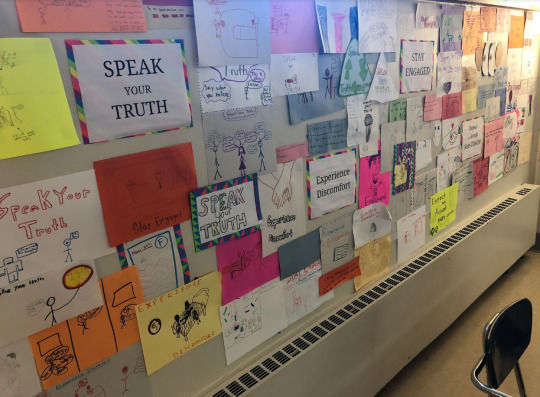
I only really have four rules in my room, and I stole them from The Pacific Education Group’s protocol for Courageous Conversations. On the very first day of school, I introduce those four rules to the students and we talk about what they mean, and how they make my classroom a little different.
For example, one of the rules is “Stay Engaged.” I ask them who likes to draw in class, and a bunch of kids raise their hands. Then, I ask them how many students know that drawing helps them pay attention, and about half keep their hands up. So, I explain, if I made a rule like “No Drawing in Class,” I’d be hurting half of you and helping half of you. If the rule is, instead, “Stay Engaged,” then you can do whatever that means for you to be engaged.
For some, staying engaged means drawing, for some not. Some may stay engaged by responding verbally to me or their classmates, and some may need to stay quiet. I had a student a few years back who was most engaged in my class when she was able to do handstands against the wall on the side of the room. OK.
The other rules work pretty much the same way: “Speak Your Truth,” “Experience Discomfort” and “Expect/Accept Non-Closure.” We talk about how your truth rather than the truth is important because it opens up the conversation to multiple perspectives.
I explain that I want them to lean into discomfort, whether that means a challenging conversation or focusing on skills and subjects they struggle with, but I don’t ever want them to feel unsafe or unwelcome. I let them know we will often leave discussions half finished at the bell. And we will not, no matter how hard we work, fix everything in the world this year, but we can be happy at any ground we gain.
I don’t really talk that long. I hope I don’t. Mainly, we get the ideas out there, and then students make little signs to hang up around the four rules, or agreements. We talk about how it looks and feels for them to do those things. They go up the night of the first day and hang there the rest of the year for easy reference.
Day Two: One Word
On the second day of school, I walk students through an identity exercise. I do one myself in front of the room to model the kind of words and thinking they could be doing, but also let them know there’s not any real way to do it wrong.
I hand them this sheet, and they fill in five words that define them (mine this year were Anxiety, Dad, Writer, Teacher, Social Justice Warrior). We talk about what it’s like to define ourselves in such a narrow way, about all the parts of us that didn’t make the list, about how any time we try to reduce ourselves or someone else to a list like that, we are missing big things about that person.
Then—and this is where it gets difficult—we cross a word off. There is much yelling. It is glorious.
When I first did this exercise during a training a whole bunch of years ago in a district that doesn’t even exist anymore, teachers rebelled in every way possible from having to cross out pieces of themselves, even hypothetically, because it was too painful to do. We had a good discussion about how often we ask students to do exactly that, to erase some part of themselves, in the very non-hypothetical space of our classroom.
Still, it’s hard to cross those words off, and harder still as we continue, crossing off one word after another, each time taking small breaks to discuss our reasoning and process. In the end, we end with a single word, a word that we have decided is, at least on that day and in that moment, is the most essential piece of our own identity. This year, mine was “teacher,” which is a departure from many, many years, when “writer” has won the day.
Students then pick out some paper and markers and stuff and write down their one word. After school, I get a whole bunch of tape and a decent podcast, and tape them all up on the wall. It’s a beautiful thing, this physical representation of all these wonderful people, of the diversity in who they are and how they see themselves. The next morning, students from all hours came in early to read through the wall. They stood with their friends, pointing proudly at their sign. They said, “There I am, that’s me.”
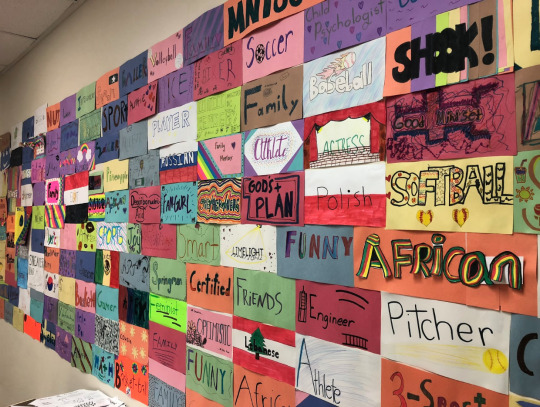
Day Three: What I Bring
On the third day of school, students get this packet, and start work on a project that will show what they bring with them into the classroom every day. I’m clear that when I ask this, I’m not looking for them to talk about the pens and folders and stuff they bring with them, but instead key parts of their identity, their passions, their personal history, their interests and personality.
The students have a couple days to brainstorm and work on them, and then we take a few days to share. We put the desks in a big circle (which always makes me think of this), and each student gets a few minutes to show what they made, explain why they made it and answer questions from the class about themselves.
This year, I had a student who didn’t want to make art, so he made a computer program that would randomly produce an image. Another student showed us a digital model of one of his favorite kinds of math equations. Yet another took the opinion section of the newspaper and used it as a canvas to re-create a famous Banksy image.
I could go on, 147 more times, at all the cool things students brought in. They all, each one of them, hang in a circle around the top of my room. Some speak of their faith, or their favorite sport, or their family or where they’re from. It’s a great way to get to know students on their terms, and also a way to make sure that, in addition to their one word, students all have a piece of the classroom that is exactly their own.
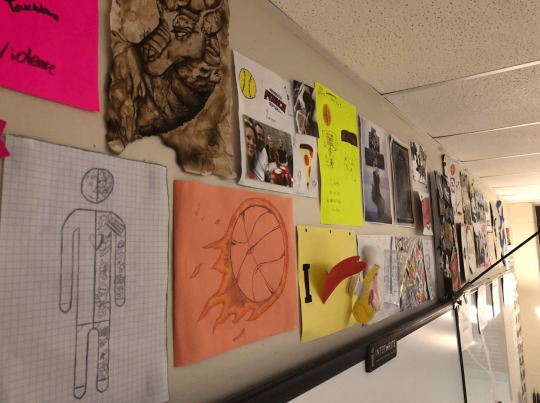
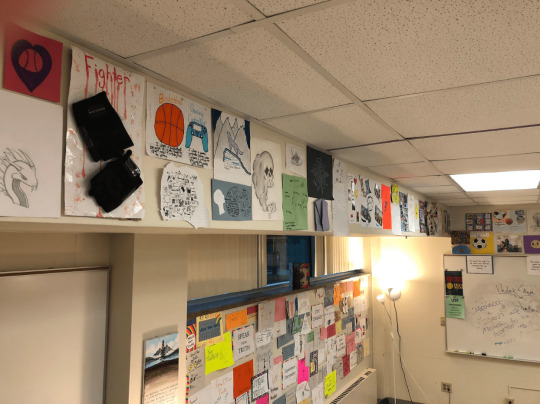
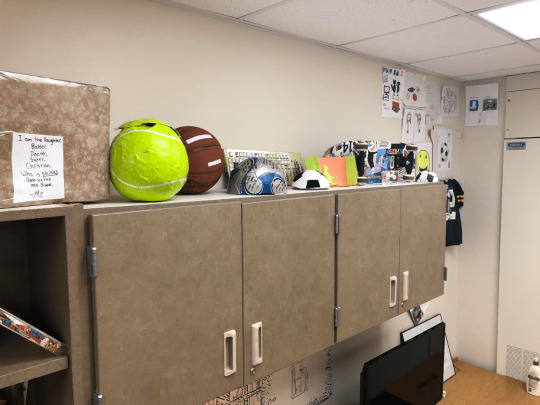
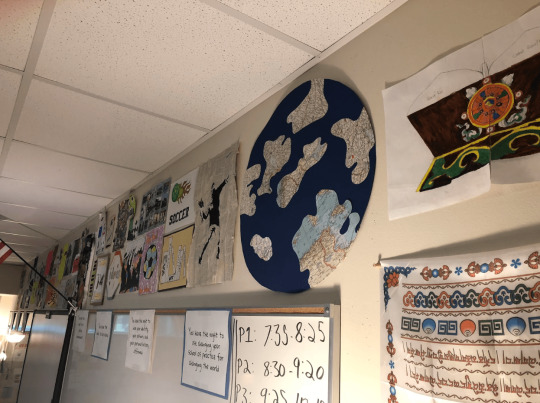
Photos courtesy of Tom Rademacher.
Before I Come to Your Classroom, Let Me Show You Mine syndicated from https://sapsnkraguide.wordpress.com
0 notes
Text
Before I Come to Your Classroom, Let Me Show You Mine
Hi.
I’m going to spend the rest of the year traveling to classrooms all over the country and talking about the things we are doing super well, and some of the things we could be doing a whole lot better.
I’m sitting in my classroom writing this, late on a Friday afternoon, enjoying the short quiet after a long, loud week. I’m looking around my room, dimly lit and breathing slowly, like the set of a play between performances. If you’re a teacher, I bet I’d like to come visit you soon. Before I do, I thought I’d show you around my room and what I do with my students the first week of school.
I really love my room, and it seems like students do, too. I don’t have a class first hour, but there are always five to 10 kids in here before school hanging out. My desks are old and…desky. I don’t have a lot of room or money for flex seating, and I don’t have the eye or time for Pinterest-worthy bulletin boards. Still, my walls, like my room, are a whole lot better when given to the kids.
It Took a Year to Create a Classroom Library with Books Kids Want to Keep
I am absurdly proud of my classroom library. When I moved into my new classroom last fall, the library was suffering badly from being out-of-date and almost entirely full of White writers. In one year, I have done a whole bunch of stuff to bring the collection to where it is now. I’m not done, not by a long-shot, but my collection now includes many books by people of color and indigenous writers.
I’ve always believed in the power of diverse reading choices, but this year I’ve been especially aware of how important it is to my students. I have a ton of graphic novels and superhero comics, and have started to add books in some of the languages spoken by my students that are not English. My students from Tibet and Haiti have been so happy to see books by and about their people.
I had a student walk down from the high school this week, looking to borrow a copy of “The Hate U Give.” I started the year with 15 on my shelf and was already down to my last two. I don’t know her name, but she left with a book. I’m not all that worried about getting it back.
By far, the books are the most expensive part of my room, made more so by my not having any sort of book check-out system and encouraging students to take books that seem interesting to them. I’ve written some grants in the last year that have helped out, have sought donations through a constantly updated Amazon wishlist, and have made some money through writing that I’ve often used to buy every book I can that my students may enjoy.
Also, these pictures are from before school started. The library is now a well-used mess and it is perfect.
Now, let me show you how our first week together went down.
Day One: Four Agreements
I only really have four rules in my room, and I stole them from The Pacific Education Group’s protocol for Courageous Conversations. On the very first day of school, I introduce those four rules to the students and we talk about what they mean, and how they make my classroom a little different.
For example, one of the rules is “Stay Engaged.” I ask them who likes to draw in class, and a bunch of kids raise their hands. Then, I ask them how many students know that drawing helps them pay attention, and about half keep their hands up. So, I explain, if I made a rule like “No Drawing in Class,” I’d be hurting half of you and helping half of you. If the rule is, instead, “Stay Engaged,” then you can do whatever that means for you to be engaged.
For some, staying engaged means drawing, for some not. Some may stay engaged by responding verbally to me or their classmates, and some may need to stay quiet. I had a student a few years back who was most engaged in my class when she was able to do handstands against the wall on the side of the room. OK.
The other rules work pretty much the same way: “Speak Your Truth,” “Experience Discomfort” and “Expect/Accept Non-Closure.” We talk about how your truth rather than the truth is important because it opens up the conversation to multiple perspectives.
I explain that I want them to lean into discomfort, whether that means a challenging conversation or focusing on skills and subjects they struggle with, but I don’t ever want them to feel unsafe or unwelcome. I let them know we will often leave discussions half finished at the bell. And we will not, no matter how hard we work, fix everything in the world this year, but we can be happy at any ground we gain.
I don’t really talk that long. I hope I don’t. Mainly, we get the ideas out there, and then students make little signs to hang up around the four rules, or agreements. We talk about how it looks and feels for them to do those things. They go up the night of the first day and hang there the rest of the year for easy reference.
Day Two: One Word
On the second day of school, I walk students through an identity exercise. I do one myself in front of the room to model the kind of words and thinking they could be doing, but also let them know there’s not any real way to do it wrong.
I hand them this sheet, and they fill in five words that define them (mine this year were Anxiety, Dad, Writer, Teacher, Social Justice Warrior). We talk about what it’s like to define ourselves in such a narrow way, about all the parts of us that didn’t make the list, about how any time we try to reduce ourselves or someone else to a list like that, we are missing big things about that person.
Then—and this is where it gets difficult—we cross a word off. There is much yelling. It is glorious.
When I first did this exercise during a training a whole bunch of years ago in a district that doesn’t even exist anymore, teachers rebelled in every way possible from having to cross out pieces of themselves, even hypothetically, because it was too painful to do. We had a good discussion about how often we ask students to do exactly that, to erase some part of themselves, in the very non-hypothetical space of our classroom.
Still, it’s hard to cross those words off, and harder still as we continue, crossing off one word after another, each time taking small breaks to discuss our reasoning and process. In the end, we end with a single word, a word that we have decided is, at least on that day and in that moment, is the most essential piece of our own identity. This year, mine was “teacher,” which is a departure from many, many years, when “writer” has won the day.
Students then pick out some paper and markers and stuff and write down their one word. After school, I get a whole bunch of tape and a decent podcast, and tape them all up on the wall. It’s a beautiful thing, this physical representation of all these wonderful people, of the diversity in who they are and how they see themselves. The next morning, students from all hours came in early to read through the wall. They stood with their friends, pointing proudly at their sign. They said, “There I am, that’s me.”
Day Three: What I Bring
On the third day of school, students get this packet, and start work on a project that will show what they bring with them into the classroom every day. I’m clear that when I ask this, I’m not looking for them to talk about the pens and folders and stuff they bring with them, but instead key parts of their identity, their passions, their personal history, their interests and personality.
The students have a couple days to brainstorm and work on them, and then we take a few days to share. We put the desks in a big circle (which always makes me think of this), and each student gets a few minutes to show what they made, explain why they made it and answer questions from the class about themselves.
This year, I had a student who didn’t want to make art, so he made a computer program that would randomly produce an image. Another student showed us a digital model of one of his favorite kinds of math equations. Yet another took the opinion section of the newspaper and used it as a canvas to re-create a famous Banksy image.
I could go on, 147 more times, at all the cool things students brought in. They all, each one of them, hang in a circle around the top of my room. Some speak of their faith, or their favorite sport, or their family or where they’re from. It’s a great way to get to know students on their terms, and also a way to make sure that, in addition to their one word, students all have a piece of the classroom that is exactly their own.
Photos courtesy of Tom Rademacher.
Before I Come to Your Classroom, Let Me Show You Mine syndicated from https://sapsnkraguide.wordpress.com
0 notes
Text
Before I Come to Your Classroom, Let Me Show You Mine
Hi.
I’m going to spend the rest of the year traveling to classrooms all over the country and talking about the things we are doing super well, and some of the things we could be doing a whole lot better.
I’m sitting in my classroom writing this, late on a Friday afternoon, enjoying the short quiet after a long, loud week. I’m looking around my room, dimly lit and breathing slowly, like the set of a play between performances. If you’re a teacher, I bet I’d like to come visit you soon. Before I do, I thought I’d show you around my room and what I do with my students the first week of school.
I really love my room, and it seems like students do, too. I don’t have a class first hour, but there are always five to 10 kids in here before school hanging out. My desks are old and…desky. I don’t have a lot of room or money for flex seating, and I don’t have the eye or time for Pinterest-worthy bulletin boards. Still, my walls, like my room, are a whole lot better when given to the kids.
It Took a Year to Create a Classroom Library with Books Kids Want to Keep
I am absurdly proud of my classroom library. When I moved into my new classroom last fall, the library was suffering badly from being out-of-date and almost entirely full of White writers. In one year, I have done a whole bunch of stuff to bring the collection to where it is now. I’m not done, not by a long-shot, but my collection now includes many books by people of color and indigenous writers.
I’ve always believed in the power of diverse reading choices, but this year I’ve been especially aware of how important it is to my students. I have a ton of graphic novels and superhero comics, and have started to add books in some of the languages spoken by my students that are not English. My students from Tibet and Haiti have been so happy to see books by and about their people.
I had a student walk down from the high school this week, looking to borrow a copy of “The Hate U Give.” I started the year with 15 on my shelf and was already down to my last two. I don’t know her name, but she left with a book. I’m not all that worried about getting it back.
By far, the books are the most expensive part of my room, made more so by my not having any sort of book check-out system and encouraging students to take books that seem interesting to them. I’ve written some grants in the last year that have helped out, have sought donations through a constantly updated Amazon wishlist, and have made some money through writing that I’ve often used to buy every book I can that my students may enjoy.
Also, these pictures are from before school started. The library is now a well-used mess and it is perfect.
Now, let me show you how our first week together went down.
Day One: Four Agreements
I only really have four rules in my room, and I stole them from The Pacific Education Group’s protocol for Courageous Conversations. On the very first day of school, I introduce those four rules to the students and we talk about what they mean, and how they make my classroom a little different.
For example, one of the rules is “Stay Engaged.” I ask them who likes to draw in class, and a bunch of kids raise their hands. Then, I ask them how many students know that drawing helps them pay attention, and about half keep their hands up. So, I explain, if I made a rule like “No Drawing in Class,” I’d be hurting half of you and helping half of you. If the rule is, instead, “Stay Engaged,” then you can do whatever that means for you to be engaged.
For some, staying engaged means drawing, for some not. Some may stay engaged by responding verbally to me or their classmates, and some may need to stay quiet. I had a student a few years back who was most engaged in my class when she was able to do handstands against the wall on the side of the room. OK.
The other rules work pretty much the same way: “Speak Your Truth,” “Experience Discomfort” and “Expect/Accept Non-Closure.” We talk about how your truth rather than the truth is important because it opens up the conversation to multiple perspectives.
I explain that I want them to lean into discomfort, whether that means a challenging conversation or focusing on skills and subjects they struggle with, but I don’t ever want them to feel unsafe or unwelcome. I let them know we will often leave discussions half finished at the bell. And we will not, no matter how hard we work, fix everything in the world this year, but we can be happy at any ground we gain.
I don’t really talk that long. I hope I don’t. Mainly, we get the ideas out there, and then students make little signs to hang up around the four rules, or agreements. We talk about how it looks and feels for them to do those things. They go up the night of the first day and hang there the rest of the year for easy reference.
Day Two: One Word
On the second day of school, I walk students through an identity exercise. I do one myself in front of the room to model the kind of words and thinking they could be doing, but also let them know there’s not any real way to do it wrong.
I hand them this sheet, and they fill in five words that define them (mine this year were Anxiety, Dad, Writer, Teacher, Social Justice Warrior). We talk about what it’s like to define ourselves in such a narrow way, about all the parts of us that didn’t make the list, about how any time we try to reduce ourselves or someone else to a list like that, we are missing big things about that person.
Then—and this is where it gets difficult—we cross a word off. There is much yelling. It is glorious.
When I first did this exercise during a training a whole bunch of years ago in a district that doesn’t even exist anymore, teachers rebelled in every way possible from having to cross out pieces of themselves, even hypothetically, because it was too painful to do. We had a good discussion about how often we ask students to do exactly that, to erase some part of themselves, in the very non-hypothetical space of our classroom.
Still, it’s hard to cross those words off, and harder still as we continue, crossing off one word after another, each time taking small breaks to discuss our reasoning and process. In the end, we end with a single word, a word that we have decided is, at least on that day and in that moment, is the most essential piece of our own identity. This year, mine was “teacher,” which is a departure from many, many years, when “writer” has won the day.
Students then pick out some paper and markers and stuff and write down their one word. After school, I get a whole bunch of tape and a decent podcast, and tape them all up on the wall. It’s a beautiful thing, this physical representation of all these wonderful people, of the diversity in who they are and how they see themselves. The next morning, students from all hours came in early to read through the wall. They stood with their friends, pointing proudly at their sign. They said, “There I am, that’s me.”
Day Three: What I Bring
On the third day of school, students get this packet, and start work on a project that will show what they bring with them into the classroom every day. I’m clear that when I ask this, I’m not looking for them to talk about the pens and folders and stuff they bring with them, but instead key parts of their identity, their passions, their personal history, their interests and personality.
The students have a couple days to brainstorm and work on them, and then we take a few days to share. We put the desks in a big circle (which always makes me think of this), and each student gets a few minutes to show what they made, explain why they made it and answer questions from the class about themselves.
This year, I had a student who didn’t want to make art, so he made a computer program that would randomly produce an image. Another student showed us a digital model of one of his favorite kinds of math equations. Yet another took the opinion section of the newspaper and used it as a canvas to re-create a famous Banksy image.
I could go on, 147 more times, at all the cool things students brought in. They all, each one of them, hang in a circle around the top of my room. Some speak of their faith, or their favorite sport, or their family or where they’re from. It’s a great way to get to know students on their terms, and also a way to make sure that, in addition to their one word, students all have a piece of the classroom that is exactly their own.
Photos courtesy of Tom Rademacher.
Before I Come to Your Classroom, Let Me Show You Mine syndicated from https://sapsnkraguide.wordpress.com
0 notes
Text
Before I Come to Your Classroom, Let Me Show You Mine
Hi.
I’m going to spend the rest of the year traveling to classrooms all over the country and talking about the things we are doing super well, and some of the things we could be doing a whole lot better.
I’m sitting in my classroom writing this, late on a Friday afternoon, enjoying the short quiet after a long, loud week. I’m looking around my room, dimly lit and breathing slowly, like the set of a play between performances. If you’re a teacher, I bet I’d like to come visit you soon. Before I do, I thought I’d show you around my room and what I do with my students the first week of school.
I really love my room, and it seems like students do, too. I don’t have a class first hour, but there are always five to 10 kids in here before school hanging out. My desks are old and…desky. I don’t have a lot of room or money for flex seating, and I don’t have the eye or time for Pinterest-worthy bulletin boards. Still, my walls, like my room, are a whole lot better when given to the kids.
It Took a Year to Create a Classroom Library with Books Kids Want to Keep
I am absurdly proud of my classroom library. When I moved into my new classroom last fall, the library was suffering badly from being out-of-date and almost entirely full of White writers. In one year, I have done a whole bunch of stuff to bring the collection to where it is now. I’m not done, not by a long-shot, but my collection now includes many books by people of color and indigenous writers.
I’ve always believed in the power of diverse reading choices, but this year I’ve been especially aware of how important it is to my students. I have a ton of graphic novels and superhero comics, and have started to add books in some of the languages spoken by my students that are not English. My students from Tibet and Haiti have been so happy to see books by and about their people.
I had a student walk down from the high school this week, looking to borrow a copy of “The Hate U Give.” I started the year with 15 on my shelf and was already down to my last two. I don’t know her name, but she left with a book. I’m not all that worried about getting it back.
By far, the books are the most expensive part of my room, made more so by my not having any sort of book check-out system and encouraging students to take books that seem interesting to them. I’ve written some grants in the last year that have helped out, have sought donations through a constantly updated Amazon wishlist, and have made some money through writing that I’ve often used to buy every book I can that my students may enjoy.
Also, these pictures are from before school started. The library is now a well-used mess and it is perfect.
Now, let me show you how our first week together went down.
Day One: Four Agreements
I only really have four rules in my room, and I stole them from The Pacific Education Group’s protocol for Courageous Conversations. On the very first day of school, I introduce those four rules to the students and we talk about what they mean, and how they make my classroom a little different.
For example, one of the rules is “Stay Engaged.” I ask them who likes to draw in class, and a bunch of kids raise their hands. Then, I ask them how many students know that drawing helps them pay attention, and about half keep their hands up. So, I explain, if I made a rule like “No Drawing in Class,” I’d be hurting half of you and helping half of you. If the rule is, instead, “Stay Engaged,” then you can do whatever that means for you to be engaged.
For some, staying engaged means drawing, for some not. Some may stay engaged by responding verbally to me or their classmates, and some may need to stay quiet. I had a student a few years back who was most engaged in my class when she was able to do handstands against the wall on the side of the room. OK.
The other rules work pretty much the same way: “Speak Your Truth,” “Experience Discomfort” and “Expect/Accept Non-Closure.” We talk about how your truth rather than the truth is important because it opens up the conversation to multiple perspectives.
I explain that I want them to lean into discomfort, whether that means a challenging conversation or focusing on skills and subjects they struggle with, but I don’t ever want them to feel unsafe or unwelcome. I let them know we will often leave discussions half finished at the bell. And we will not, no matter how hard we work, fix everything in the world this year, but we can be happy at any ground we gain.
I don’t really talk that long. I hope I don’t. Mainly, we get the ideas out there, and then students make little signs to hang up around the four rules, or agreements. We talk about how it looks and feels for them to do those things. They go up the night of the first day and hang there the rest of the year for easy reference.
Day Two: One Word
On the second day of school, I walk students through an identity exercise. I do one myself in front of the room to model the kind of words and thinking they could be doing, but also let them know there’s not any real way to do it wrong.
I hand them this sheet, and they fill in five words that define them (mine this year were Anxiety, Dad, Writer, Teacher, Social Justice Warrior). We talk about what it’s like to define ourselves in such a narrow way, about all the parts of us that didn’t make the list, about how any time we try to reduce ourselves or someone else to a list like that, we are missing big things about that person.
Then—and this is where it gets difficult—we cross a word off. There is much yelling. It is glorious.
When I first did this exercise during a training a whole bunch of years ago in a district that doesn’t even exist anymore, teachers rebelled in every way possible from having to cross out pieces of themselves, even hypothetically, because it was too painful to do. We had a good discussion about how often we ask students to do exactly that, to erase some part of themselves, in the very non-hypothetical space of our classroom.
Still, it’s hard to cross those words off, and harder still as we continue, crossing off one word after another, each time taking small breaks to discuss our reasoning and process. In the end, we end with a single word, a word that we have decided is, at least on that day and in that moment, is the most essential piece of our own identity. This year, mine was “teacher,” which is a departure from many, many years, when “writer” has won the day.
Students then pick out some paper and markers and stuff and write down their one word. After school, I get a whole bunch of tape and a decent podcast, and tape them all up on the wall. It’s a beautiful thing, this physical representation of all these wonderful people, of the diversity in who they are and how they see themselves. The next morning, students from all hours came in early to read through the wall. They stood with their friends, pointing proudly at their sign. They said, “There I am, that’s me.”
Day Three: What I Bring
On the third day of school, students get this packet, and start work on a project that will show what they bring with them into the classroom every day. I’m clear that when I ask this, I’m not looking for them to talk about the pens and folders and stuff they bring with them, but instead key parts of their identity, their passions, their personal history, their interests and personality.
The students have a couple days to brainstorm and work on them, and then we take a few days to share. We put the desks in a big circle (which always makes me think of this), and each student gets a few minutes to show what they made, explain why they made it and answer questions from the class about themselves.
This year, I had a student who didn’t want to make art, so he made a computer program that would randomly produce an image. Another student showed us a digital model of one of his favorite kinds of math equations. Yet another took the opinion section of the newspaper and used it as a canvas to re-create a famous Banksy image.
I could go on, 147 more times, at all the cool things students brought in. They all, each one of them, hang in a circle around the top of my room. Some speak of their faith, or their favorite sport, or their family or where they’re from. It’s a great way to get to know students on their terms, and also a way to make sure that, in addition to their one word, students all have a piece of the classroom that is exactly their own.
Photos courtesy of Tom Rademacher.
Before I Come to Your Classroom, Let Me Show You Mine syndicated from https://sapsnkraguide.wordpress.com
0 notes